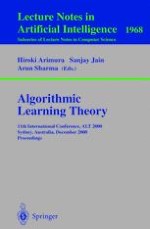2000 | Buch
Algorithmic Learning Theory
11th International Conference, ALT 2000 Sydney, Australia, December 11–13, 2000 Proceedings
herausgegeben von: Hiroki Arimura, Sanjay Jain, Arun Sharma
Verlag: Springer Berlin Heidelberg
Buchreihe : Lecture Notes in Computer Science
Enthalten in: Professional Book Archive
